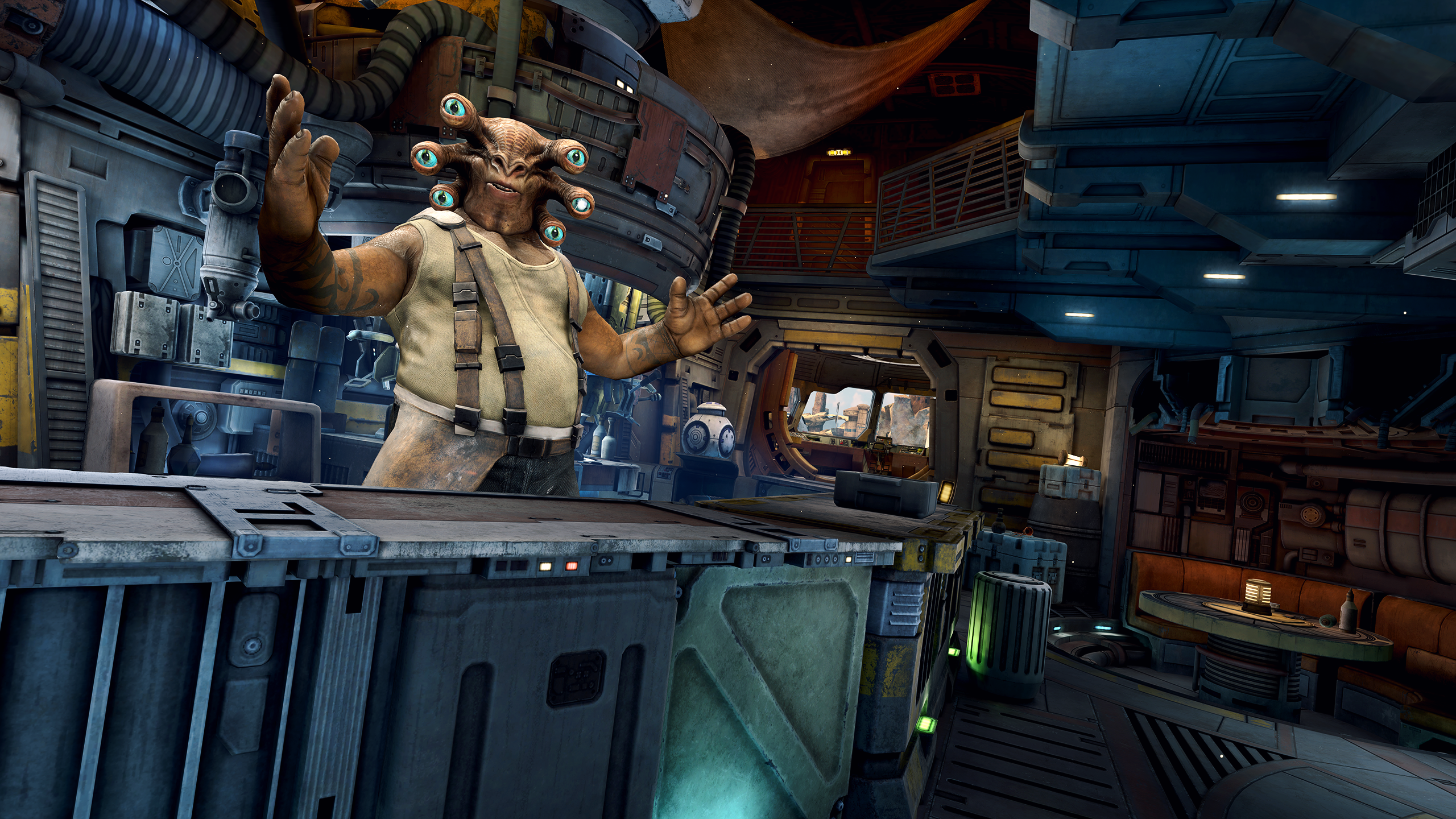
Star Wars fans often want the impossible.
I should know, I’ve been one since the day my mom took me to see Star Wars — we didn’t call it A New Hope back then — during one of its theatrical rereleases.
Since then I’ve been chasing all the things I felt that day, and discovering new feelings and making new friends, fictional and real, along the way.
Star Wars: Tales from the Galaxy’s Edge is a hearty reminder that I’m not the only one chasing those feelings, and that a great number of people who do happen to work at the place where that matters most: Lucasfilm. In this particular case ILMxLAB, which has been given the challenge of bringing to life a new era of immersive storytelling.
Tales from… is the fifth commercial Star Wars title from ILMxLAB, which previously released the three episode arc Vader Immortal for Oculus and PSVR, and the location based VR adventure Secrets of the Empire, which acted as a prologue of sorts to the former. The current release is also framed as the start of a series, with the game’s UI promising at least two more releases.
Unlike Vader Immortal, which told one story of a nameless protagonist who was lured into a scheme of Darth Vader’s, the Tales from… project is framed as an anthology set on the world of Batuu, which was created for the Disney theme parks and is known to park goers as “Galaxy’s Edge.”
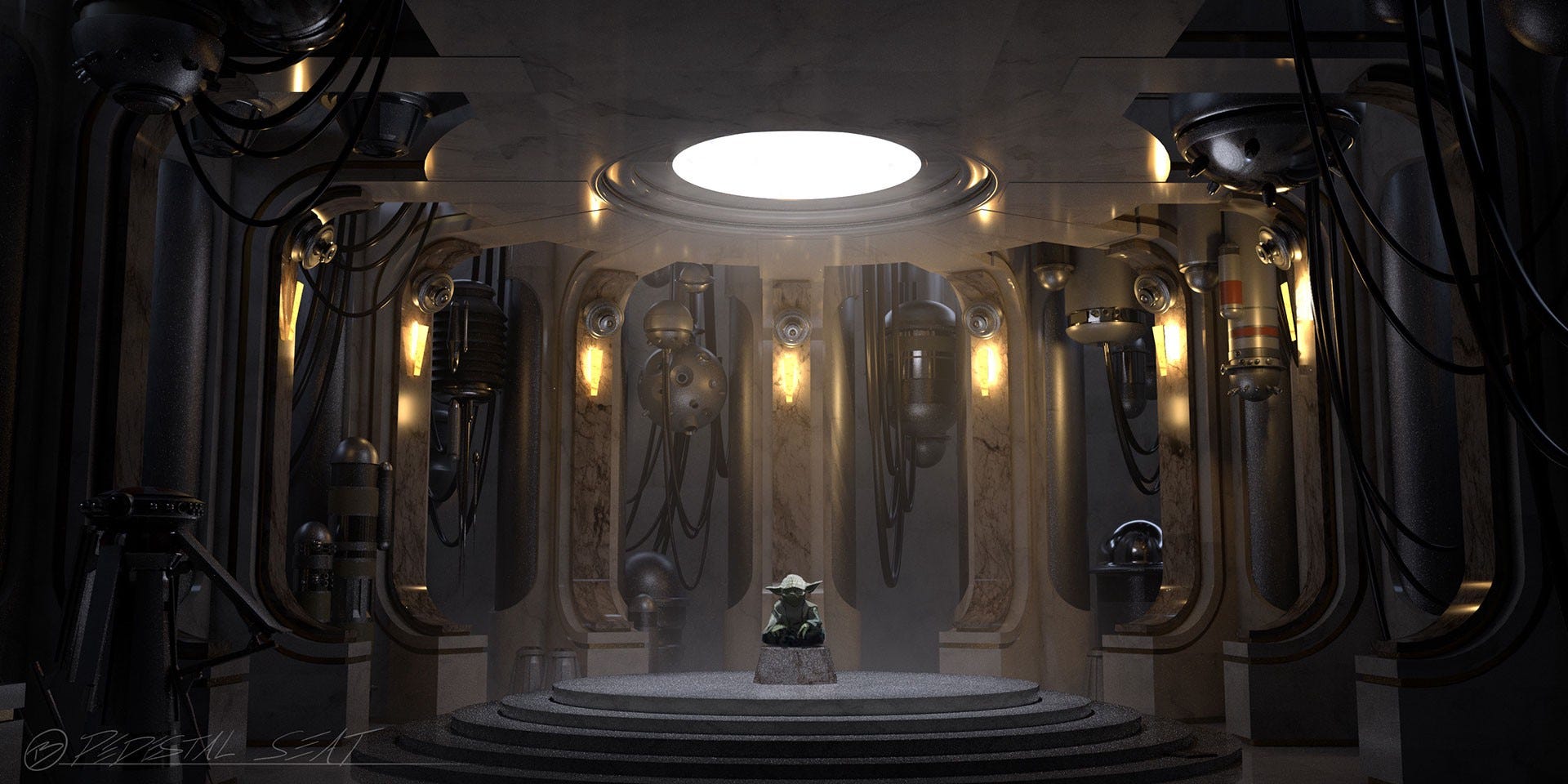
There’s a lot going on with Tales from… in terms of new mechanics, characters, environments, and at points even some novel narrative techniques. Although not all at once. Which can leave the overall package feeling like a “chess piece” episode of a TV series. You can sense that what’s coming is going to be great, but there’s some credits that need rolling first.
The bulk of the offering tells the story of a droid technician (the player) who works for a diminutive Utai named Mubo (Matthew Wood), the owner of Black Spire Outpost’s Droid Depot. This is one of the actual shops you can find at the Disney theme parks. Sadly, we’ve yet to see Mubo in the parks, even though he’s made appearances in other tie-ins. We don’t start on familiar ground, however, but on the cargo ship that’s delivering droids to the depot. This gives us the first few minutes to orient ourselves to the ship around us, test out the tools that we’ve been given to navigate the world, and marvel at the level of detail that bring a very specific Galaxy’s Edge aesthetic home.
It’s here where many of the new gameplay elements are added to ILMxLAB’s palette. While Vader Immortal focused on the Force, lightsabers, and some light puzzling with no real fail states, Tales from… brings in a host of more traditional game options.
For starters: you have a health meter. Which means you can die.
I did. A lot. We’ll get to that.
You also have a vial of first aid (a bacta spray, for my fellow pedants) which can get your health back up. That slots into a spot on your wrist. On the opposite wrist is your comms/scanner/wayfinder, the later of which takes the place of a minimap. It’s all rather intuitive, although hitting virtual buttons with your virtual fingers can be tricky when you’re also holding a blaster. Which you’re probably doing, along with one on each hip.
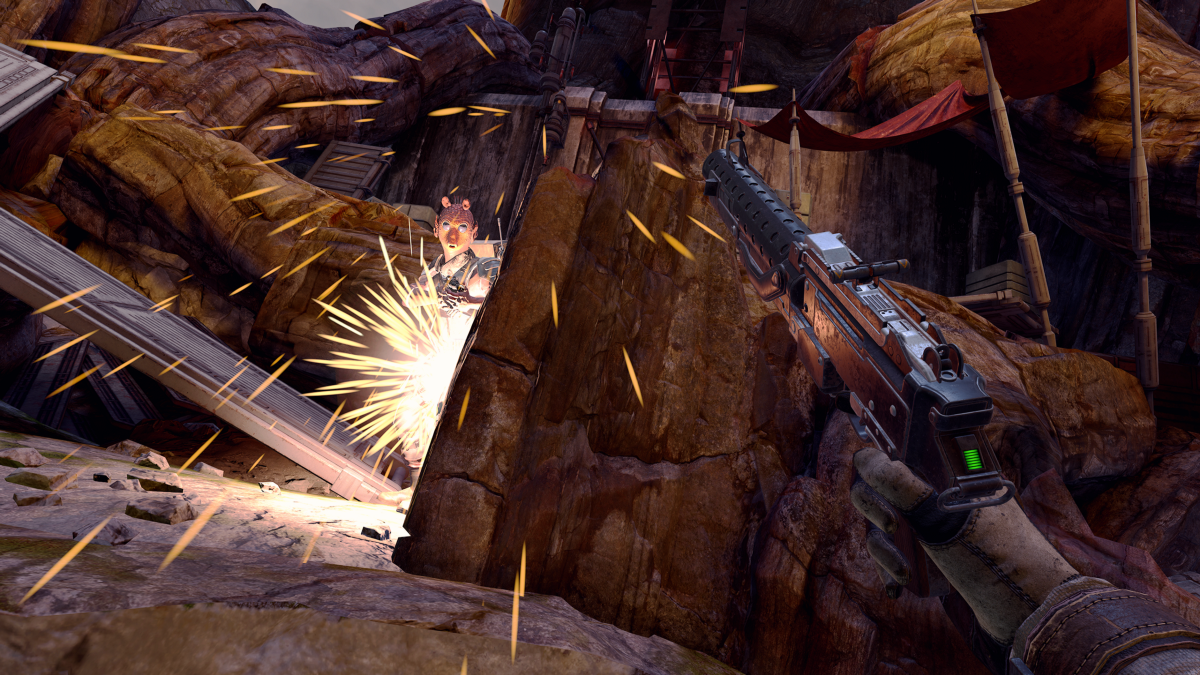
You’re holding so many blasters because you can’t reload, so no John Wick for you, but you can go full John Woo and have a gun in each hand along with the aforementioned one on each hip. They run out of ammo frequently enough that this is not a ridiculous sartorial choice so much as it is sound strategy. Aside from when you need a hand to pick up collectibles, use the All-Tool on your belt to help solve puzzles, use the bacta spray, throw thermal detonators, and interact with other parts of the environment. In short: there are times when I wished I was a four-handed Besalisk and not a two handed human.
Still, this is what the real life of a video-game adventurer would be like: juggling lots of equipment. The design team shows us a degree of mercy, in that you pretty much have unlimited storage for things in the form of a pouch that sits near your heart. Like D&D’s famous “bag of holding” you can put endless amounts of anything in there. Although I’m only just now realizing I never put any guns in it. Whomp rats. I should have tried that.
In all: it’s a pretty good translation of the core mechanics of adventure games like, say Tomb Raider, into the embodied needs of VR. If you think too hard about it, it just shows how ridiculous video games are when it comes to loading us up with stuff. Luckily, I’ve played a lot of video games, so I didn’t think too hard about that. All in all there’s a solid foundation for an adventure game here, but aside from the deadliness of some of the opponents (you will come to hate seeker droids with a passion), the main quest never fully tested me.
Sure, the design of some of the spaces left me in awe, or provided me with a much needed fix of life on Batuu — as a former pass holder for Disneyland, I’m really missing BSO — and all of that is worth the price of admission alone. Yet while I found myself feeling at times like I had stepped into a lost level from the classic game Dark Forces, or gotten lost in a part of the theme park tourists never see, the core story didn’t sizzle the way Vader Immortal did. At least, not for the stretches of time where our nameless, faceless, voiceless protagonist is tasked with shooting it out with the foot soldiers of the Guavian Death Gang.
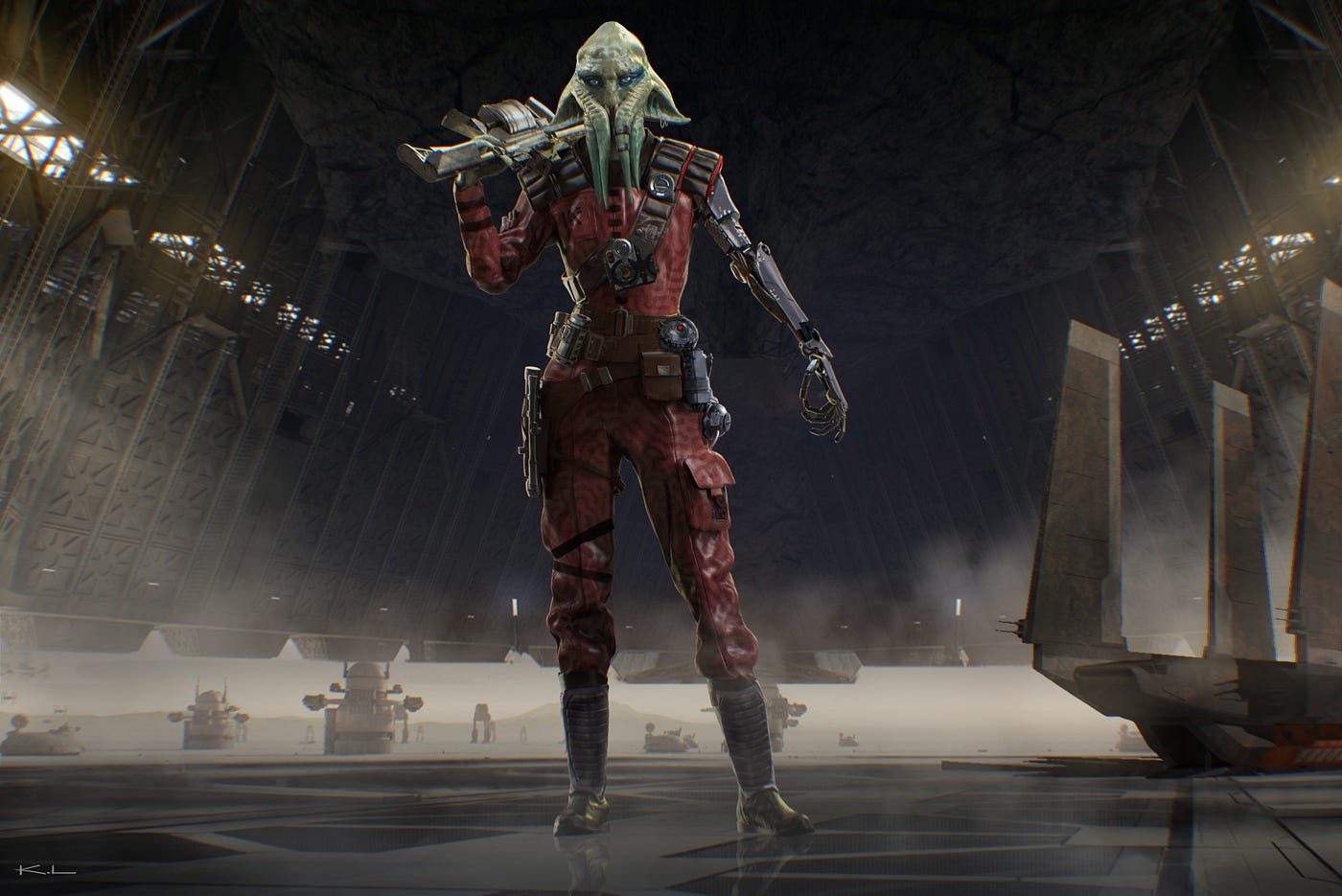
The good news is that the supporting cast of characters really make the main quest of the game shine. Whether that’s a moment with Mubo, or time spent with the bartender Seezelslak (an avuncular Bobby Moynihan). Best of all are the encounters with the villainous pirate Tara Rashin, a Quarren (you know, the aliens with the squid heads) underboss of the Death Gang voiced by Debra Wilson. These are the moments when the gameplay takes on a sense of urgency, fueled by Wilson’s performance, with the melodramatic, yet grounded, flair that is the dramatic anchor of Star Wars. Which makes sense, as Wilson is no stranger to a galaxy far, far away, having been one of the stars of last year’s Jedi: Fallen Order and also voicing a character in The Rise of Skywalker.
Get Noah J Nelson’s stories in your inbox
Join Medium for free to get updates from this writer.
SubscribeSubscribe
The tension in these encounters throws the bulk of the fights into contrast: insofar as they are nerve-wracking, it is because of the basic chaos of a gunfight in 360-degrees. Beyond that, the build I played on seemed to have some issues with positional audio, with people and creatures that should have sounded far away feeling like they were right on top of me. That was probably a build bug, which comes with the territory when you’re reviewing launch week code. It wasn’t a fun-killer, if it did throw me out a little.
It is here I will note that I had some calibration issues with height, which may have affected my aim, and thus my playthrough. Maybe. The game very generously lets you adjust your virtual height to your comfort level. In fact it gives a lot of options on this front. Unfortunately, all this is a bit moot if your headset isn’t reading the floor properly, and for some reason every so often the Oculus software just decides it doesn’t like where my floor is. So it makes up its own mind about how tall I am. This has happened on two generations of hardware now.
I spent the much of the main game constantly adjusting the in-game sliders, until I went into a different program and found myself hovering six inches off the ground. That’s when I realized it was the headset. Resetting the floor height manually made things better, and I felt like I was more accurate after this. It did make me wish that the height and body position options came with a reference point inside the game, and I’d suggest that you make sure everything is in order with your hardware settings before diving into the game. You don’t want to get pulled out of the fantasy by C-3PO (actually played here by Anthony Daniels) being too short.
All that might sound like I didn’t enjoy myself during the main game: but I did! Often most when I was just looking out over Black Spire Outpost’s spaceport from the cantina’s window and seeing one of the real world places I miss most. I also found myself in a good state of flow while exploring corners of the deliciously detailed maps, or figuring out a new puzzle type.
But the reward for seeing the adventure through, provided you collect some special ingredients along the way, is the first of the tales told by Seezelslak. Future expansions will bring more stories from the bartender, but this first one is free, in a sense.
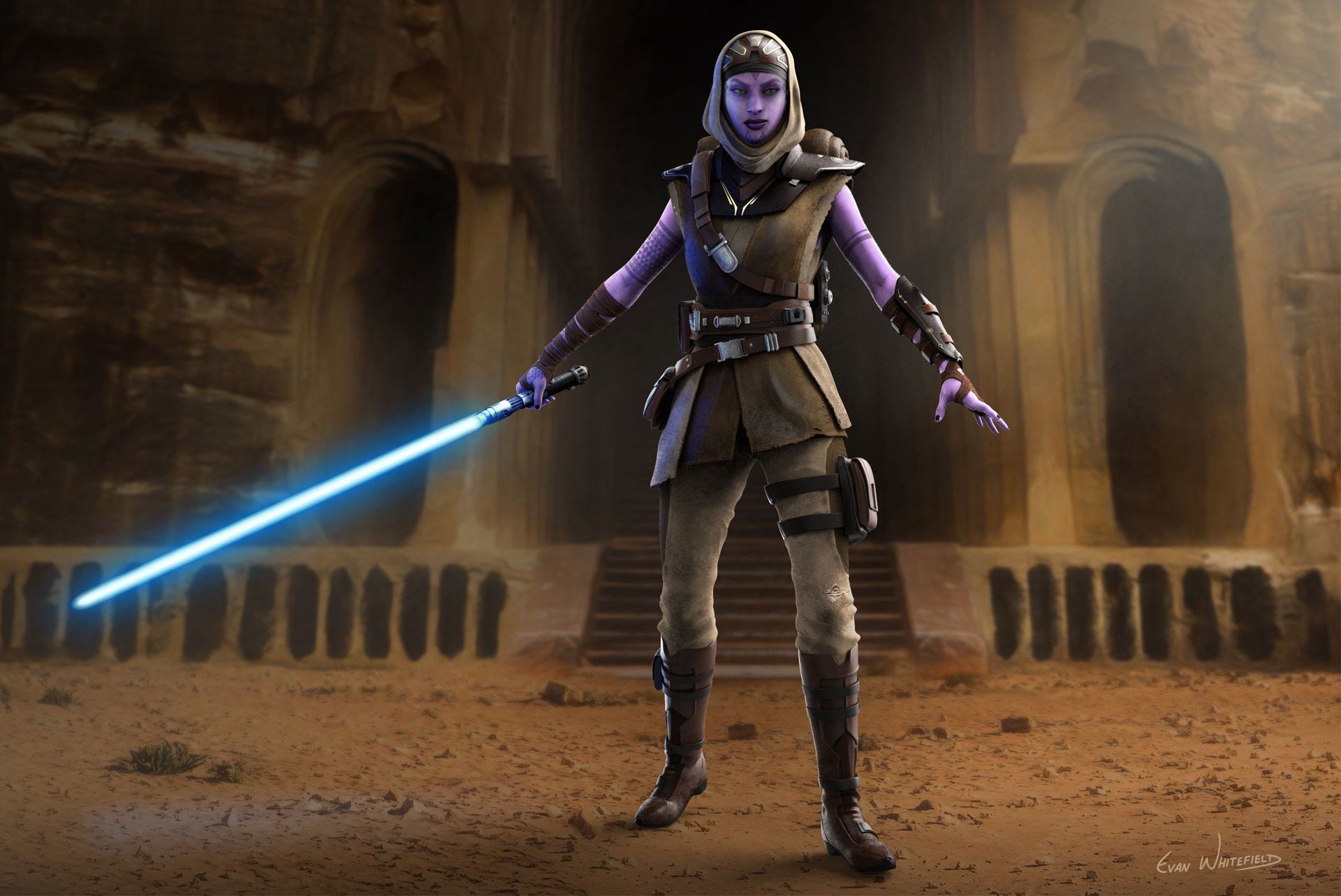
Remember a thousand and a half words ago when I said Star Wars fans often want the impossible?
Temple of Darkness, a short story that offers up our first taste of a new era for Star Wars called “The High Republic,” takes an evolutionary step forward for the narrative side of ILMxLAB’s offerings. Out is the nameless, silent protagonist. In is Ady Sun’Zee, a padawan learner and seemingly the last survivor of a horrible event that took place hundreds of years ago at the Jedi research temple on Batuu.
In both Tales from… and its predecessor, the player’s hands were represented as gloves so as not to pull us out of the fantasy that we are the one’s who are living the adventure. Here the hands are a distinctive pale purple with long fingernails. It’s a striking shift, but less striking still than the sound of Ady’s voice — actress Ellie Araiza, but now our voice — both in our head and responding to the arrival of Master Yoda (Frank Oz reprising the role he originated).
So far ILMxLAB has shied away from giving player characters a distinct identity and voice, and until Valve’s Half Life: Alyx, the same was pretty much true across the mainstream VR spectrum. While I haven’t had the opportunity to play the PC-based Alyx yet, I can say that this shift was a revelation for me. It was as if a light switch was turned on from me, and I instantly found myself acting out Araiza’s line readings.
Ady’s fear as she explored the darkened temple alone seeped into my posture. The way that I held Ady’s lightsaber was different from how I had wielded my own blade in Vader Immortal, or the “real” one I built at Savi’s and Sons in Black Spire Outpost over a year ago.
Now not everyone who plays Temple of Darkness will be doing so with a theatre degree moldering away in storage somewhere. But that instinct to play, to live out the role, is a universal trait we’re all born with and have until the world grinds it right out of us. To step into someone else’s skin if only for a few minutes and not just see but feel the world through their body. That’s the magic that VR gives us permission to chase, if designers are willing to chase it.
I’m so very, very grateful that ILMxLAB has chosen to chase that feeling, along with all the good Star Wars vibes they’ve got on lock.
My only quibble with Temple of Darkness is that it’s over almost before it has begun. While this is a complete story, it clocks in at just 15 minutes, compared with the 2–3 hours of the main quest. Much of this comes down to how quickly I became attached to Ady thanks to the dramatic structure of the story. While the tale uses notes of the Jedi lore it is filtered through Ady’s feelings, her own personal struggle with these vast cosmic powers. It wasn’t the mysterious (redacted) or even the arrival of Yoda that hooked me. It was Ady’s emotional dilemma that did me in.
Which leaves the question in place as to what this Tales from… series is going to be.
Will it be a world building exercise, fleshing out the specific lore of the theme park land? A vehicle for experimentation in VR storytelling, and what ILMxLAB calls “storyliving,” that never settles for one shape?
Or perhaps it will seek to balance the push and pull of game and story, personal and epic, using that quintessentially Star Wars path of melodramatic beats tempered by workaday aesthetics. That slight of mind that reminds us that the lives inside of us are bigger on the inside than they seem to be on the outside.
It is a way that seems impossible, but then again, impossible is where the best stories start.
Star Wars: Tales from the Galaxy’s Edge is available today for the Oculus Quest platform, and is priced at $24.99.
Discover the latest immersive events, festivals, workshops, and more at our new site EVERYTHING IMMERSIVE, new home of NoPro’s show listings.
NoPro is a labor of love made possible by our generous Patreon backers. Join them today!
In addition to the No Proscenium web site, our podcast, and our newsletters, you can find NoPro on Twitter, Facebook, YouTube, Instagram, in the Facebook community Everything Immersive, and on our Slack forum.
Office facilities provided by Thymele Arts, in Los Angeles, CA.



















Discussion